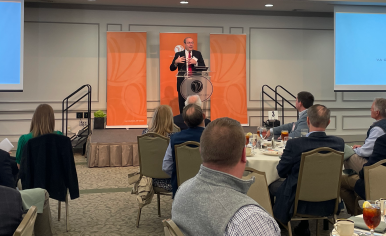Barkin: Raising interest rates is correct course
Inflation remains high, banks seem stable, Richmond Fed chief says
Barkin: Raising interest rates is correct course
Inflation remains high, banks seem stable, Richmond Fed chief says
As inflation remains high and the fallout from recent bank failures seems contained, the Federal Reserve Bank has good reason to continue raising interest rates, Federal Reserve Bank of Richmond President and CEO Tom Barkin said Thursday in a speech to the Virginia Council of CEOs at the University of Richmond.
“It is worth remembering that not every bank failure becomes Lehman Brothers,” Barkin said. “We’re all understandably scarred by the memory of 2008, but banks have failed throughout history, many without creating a broader crisis.”
On March 22, the Fed raises interest rates by a quarter-point, or 25 basis points, pushing rates to a range of 4.75% to 5%.
“If you back off on inflation too soon, inflation comes back even stronger, which requires us [the Fed] to do even more and cause even more damage,” said Barkin, who is currently an alternate member on the Fed’s powerful policy-setting Federal Open Market Committee. “With inflation high, broad-based and persistent, I just didn’t want to take that risk.”
While the broader implications from the failures of Silicon Valley Bank and Signature Bank and resulting actions taken by the Federal Deposit Insurance Corp., the Federal Reserve and Department of Treasury “aren’t yet clear,” Barkin said, banks, including in his region, the Fed’s Fifth District — a multistate region including Virginia, North Carolina, South Carolina, West Virginia and Maryland— seem to be resilient, with relatively stable deposit flows and adequate liquidity.
Meanwhile, the Fed’s interest rate increases don’t seem to be having much of an effect on inflation yet, with the headline consumer price index at 6% in February.
“Monetary policy is said famously to work with long and variable lags, but our 475 basis points of rate hikes over the past year have not yet compellingly moved inflation back to our 2% target,” Barkin explained.
Although inflation could drop quickly if banks tighten access to credit and the effects of increasing interest rates appear, Barkin said he expects it will take time for inflation to cool.
Economic disruptions from the COVID-19 pandemic continue, he said, with low vehicle and housing inventories, continuing order backlogs and a tight labor market. Consumers have unprecedented levels of wealth: “There was stimulus and suppressed spending that together still haven’t been put in the economy — well over a trillion dollars,” Barkin said.
Barkin also pointed to increasing prices and wages, as sectors like health care, utilities and food seek to restore margins to pre-pandemic levels and workers who saw a decline in their real wages seek higher wages to catch up.

High pricing is the third inflationary pressure that Barkin is watching.
“Supply chain challenges have just worn down purchasing departments,” he said. “They now seem more willing to accept increases, at a time when volatility has made supplier cost structures more opaque and availability more important.”
The Fed will have to be nimble, Barkin said, since the effects of the banking crisis and of high inflation could have wide-ranging results. “And if I’m wrong about the pricing dynamics at play, or about credit conditions, then we can respond appropriately,” he added.
On Thursday, Federal Reserve Bank of Boston President Susan Collins also backed the Fed’s decision to increase rates by a quarter-point in a speech during the National Association for Business Economics (NABE) Economic Policy Conference in Washington, D.C., according to Yahoo!Finance.
What does the future hold? What has happened in the economy in the last two or three years is almost like what happens when the country goes through a war, Barkin said, with lots of spending, monetary support, people moving in and out of jobs and inflation as a result. He’s hopeful the U.S. economy will get through the “post-war” period and calm.
“My hope is that on the backside of this is something that looks more normal,” he said, “looks more like the early ’20s, it looks like the late ’40s and early ’50s, where supply and demand have the opportunity to get back into balance through whatever combination of demand side moves, like the ones we’re making with rates, or supply side moves, like the ones I referenced earlier.”
e
















